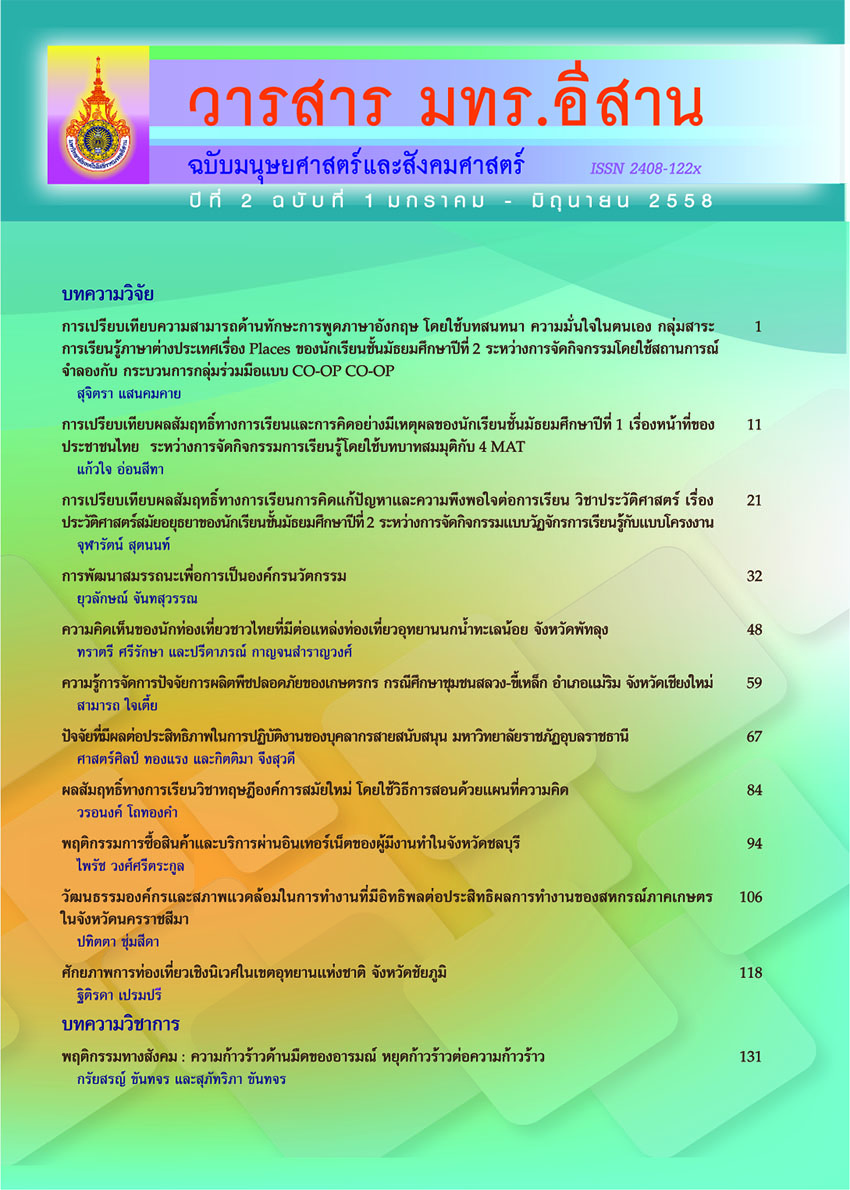Competency Development for the Innovation Organization
Main Article Content
Abstract
This research presents the competency development method for an innovative organization. The research is intended to study personal competency conformed to the culture of innovative organization, study personal competency of contact center, including design a developing model of personal competency for moving towards an innovative organization. The research and development procedures and mixed method were processed. Quantitative research was employed from the purposive sampling, 113 officers from the contact center services provider of a private company. The research instrument was questionnaire. The employed statistical analysis of data included mean , standard deviation (S.D.), percentage, Sample t-test, One-Way ANOVA and correlation & regression analysis. Qualitative research was employed using an in-depth interviewing 4 experts and performed a focus group of management team from contact center services provider for designing a developing model of personal competency.
Of findings found that the competency for moving towards an innovative organization is 2 path of core competency as follows: 1. attitude that composed of attitude toward self, attitude toward work, attitude toward organization and attitude toward social and 2. motive that composed of motivation by goal setting, motivation by achievement and prizes. The 3 path of function competency as follows: 1) knowledge that composed of job knowledge, organization knowledge. 2) skill that composed of analytical thinking skill, learning skill and practical skill. 3) attributes
The most competencies that conformed to the culture of innovative organization was the core competency in attitude and motive.
According to the research results, we have designed a developing model of personal competency of contact center for moving towards an innovative organization. The developing model called GOSOFT model which consisted of 6 components: G (Give), the director and manager should give knowledge, comprehension, time and consultant to the officers for the job, organization and innovation, O (Opportunity), the director and manager should give the opportunity to learn and to present their achievements, S (Sampler), the director and manager should be a role model for working, learning, developing innovation and morality, O (Offer), the director and manager should offer officers the prizes and admiration for making the motive to work, F (Full Communication), the director and manager should communicate to the officers thoroughly, clearly and usefully, T (Together), the director and manager should create an involvement to activities of all officers for making a good relationship and sacrifice to organization.
Article Details
บทความที่ได้รับการตีพิมพ์เป็นลิขสิทธิ์ของมหาวิทยาลัยเทคโนโลยีราชมงคลอีสาน
ข้อความที่ปรากฏในบทความแต่ละเรื่องในวารสารวิชาการเล่มนี้เป็นความคิดเห็นส่วนตัวของผู้เขียนแต่ละท่านไม่เกี่ยวข้องกับมหาวิทยาลัยเทคโนโลยีราชมงคลอีสานและคณาจารย์ท่านอื่นๆในมหาวิทยาลัยฯ แต่อย่างใด ความรับผิดชอบองค์ประกอบทั้งหมดของบทความแต่ละเรื่องเป็นของผู้เขียนแต่ละท่าน หากมีความผิดพลาดใดๆ ผู้เขียนแต่ละท่านจะรับผิดชอบบทความของตนเองแต่ผู้เดียว
References
กิตศิพัฒน์ รัตนภักดี. (2548). การวิจัยการพัฒนาสำนักงานคณะกรรมการข้าราชการพลเรือนสู่องค์กร นวัตกรรม. กรุงเทพฯ : มหาวิทยาลัยเทคโนโลยีพระจอมเกล้าธนบุรี
จุการิป อินทรเรืองศรี. (2549). การศึกษาตัวขี้วัดความเป็นองค์กรแห่งนวัตกรรมของกลุ่มพยาบาลโรงพยาบาลศูนย์. กรุงเทพฯ : จุฬาลงกรณ์มหาวิทยาลัย
ชีพีออลล. (2556). CP ALL องค์กรนวัตกรรม. เข้าถึงเมื่อ 1 พฤศจิกายน 2556. เข้าถึงได้จาก (http://www.cpall.co.th/Corporate/นวัตกรรม)
เทือน ทองแก้ว. (2552). สมรรถนะ (Competency) หลักการและแนวปฏิบัติ. เข้าถึงเมื่อ 24 มีนาคม 2553. เข้าถึงได้จาก (www.dusit.ac.th)
ธำรงค์ศักดิ์ คงคาสวัสดิ์. (2548). เริ่มต้นอย่างไรเมื่อจะนำ Competency มาใช้ไนองค์กร. กรุงเทพฯ : ส.ส.ท.
นรวัฒน์ ชคิวงศ์. (2554). การวิเคราะห์ปัจจัยที่มีอิทธิพลต่อการเป็นองค์กรแห่งนวัตกรรมในประเทศไทย. วารสารบริหารธุรกิจ. ปีที่ 34. ฉบับที่ 130. หน้า 47-58
เบ็ญจวรรณ บุญใจเพ็ชร. ค่านิยม ทัศนคติ และความพึงพอใจในงาน. เข้าถึงเมื่อ 23 กันยายน 2554. เข้าถึงได้จาก (http:/ / www.bloggang.com/mainblog.php?id--ajarnbenkmonth=20-02-2010&group-18&gblog-30)
ปกรณ์ วงศ์รัตนพิบูลย์. ทัศนคติเชิงบวกในการทำงาน. เช้าถึงเมื่อ 23 กันยายน 2554. เข้าถึงได้จาก(www.entraining.net/presentation/03_positive-attitude.ppsSimilar)
ประภาเพ็ญ สุวรรณ. ทัศนคติ. เข้าถึงเมื่อ 23 กันยายน 2554. เข้าถึงได้จาก (http: / / www.novabiz.com/Nova Ace/ Attitude.htm)
ปรียาพร วงศ์อนุตรโรจน์. (2548). จิตวิทยาอุตสาหกรรม. กรุงเทพฯ: พิมพ์ดี
ปีเตอร์ และโรแวน (2553). การสร้างนวัตกรรมให้เป็น Competency. แปลจาก (Innovation to the Core). โดย ณัฐยา สินตระการผล. กรุงเทพฯ : ส.เอเซียเพรส
พยุงศักดิ์ ชาติสุทธิผล. (2556). บทบาทและความสำคัญชองนวัตกรรมต่อการพัฒนาอุตสาหกรรมของประเทศ. เข้าถึงเมื่อ 1 พฤศจิกายน 2556. เข้าถึงได้จาก (htp://www.most go. th/main/index.php/service/information-service/open-innovation-ome/2386-2011-08-17-07-22-13.html)
พิเดชน์ เทียมรัตน์ และกานต์สุดา มาฆะศิรนนท์. (2544). วินัยสำหรับองค์กรเรียนรู้ (The Fifth Discipline). กรุงเทพฯ : เอ็กเปอร์เน็ท
พิเดชน์ เทียมรัตน์ และกานต์สุดา มาฆะศิรนนท์. (2554). วินัย 5 ประการ พื้นฐานสู่การเป็นองค์กรเรียนรู้. กรุงเทพฯ : เอ็กเปอร์เน็ท
ภาณุ ลิมมานนท์. (2549). Strategic Business Innovation Management 4G. กรุงเทพฯ : ภาริณาส
ราฟท์ เคทซ์.(2550). การบริหารจัดการนวัตกรรม. แปลจาก (Managing Creativity and Innovation). โดย ณัฐยา สินตระการผล. กรุงเพกฯ : เอ็กเปอร์เน็ท
วิลาสินี พุทธิการันต์. (2551). วิลาสินี พุทธิการันต์ : เธอคือเจ้าเเม่ Call Center. เข้าถึงเมื่อ 8 ตุลาคม 2551. เข้าถึงได้จาก (www.Marketeer.com)
แรงจูงใจ. (2551). เช้าถึงเมื่อ.28 กรกฏาคม 2554. เข้าถึงได้จาก (http:/ /dit druacth /home/023/psychology/chap5.html)
สนั่น เถาชารี. (2552). การสร้างนวัตกรรมไหม โดยอาศัยการบริการทรัพยากรมนุษย์. เข้าถึงเมื่อ 5 พฤศจิกายน 2556. เข้าถึงได้จาก (http:/ / www.tpa.or.th/writer /read_this_book_topic.php?bookID-1534& read-truecccount-true)
สมหวัง วิทยาปัญญานนท์. (2548). สร้างนวัตกรรมเป็นวัฒนธรรมองค์กร. เข้าถึงเมื่อ 6 ธันวาคม 2552. เข้าถึงได้จาก (www.budmgt.com)
สำนักงานนวัตกรรมเเห่งชาติ. (2552). นวัตกรรม. เข้าถึงเมื่อ 8 ธันวาคม 2552. เข้าถึงได้จาก (www.nia.or. th/html/FAQ/faq.htm)
อาภรณ์ ภู่วิทยพันธุ์. (2550). Career Development In Practice. กรุงเทพฯ : เอช อาร์ เซ็นเตอร์
อาภรณ์ ภู่วิทยพันธุ์. (2552). Competency Dictionary. กรุงเทพฯ : เอช อาร์ เซ็นเตอร์
อาภรณ์ ภู่วิทยพันธุ์. (2553). เทคนิคการจูงใจลูกน้องให้ท่างาน. เข้าถึงเมื่อ 4 พฤษภาคม 2556. เข้าถึงได้จาก (http:/ /register.utcc.ac. th/KM2553/33F6.html)
เอกมน โลหะญาณจารี. (2547). แรงจูงใจในการปฏิบัติงานของอาสาสมัครสาธารณสุขเขตธนบุรี. กรุงเทพฯ: มหาวิทยาลัยราชภัฏบ้านสมเด็จเจ้าพระยา
Barnard. (1972). อ้างถึงใน เอกมน โลหะญาณจารี. (2547). แรงจูงใจในการปฏิบัติงานของอาสาสมัครสาธารณสุขเขตธนบุรี กรุงเทพฯ. มหาวิทยาลัยราชภัฏบ้านสมเด็จเจ้าพระยา
Joe Tidd, John Bessant and Keith Pavitt อ้างถึงใน กิตติพัฒน์ รัตนภักดี. (2548). การวิจัยการพัฒนาสำนักงานคณะกรรมการข้าราชการพลเรือนสู่องค์กรนวัตกรรม. กรุงเทพฯ: มหาวิทยาลัยเทคโนโลยีพระจอมเกล้าธนบุรี.
Novabizz. (2554). ทัศนคติ. เข้าถึงเมื่อ 23 กันยายน 2554. เข้าถึงได้จาก (http:/ / www.novabizz.com /Nova Ace / Attitude.htm)
Parry S. B. อ้างถึงใน เทือน ทองแก้ว. (2552). สมรรถนะ (Competency) หลักการเเละแนวปฏิบัติ. เข้าถึงเมื่อ 24 มีนาคม 2553 เข้าถึงได้จาก (www.dusit.ac.th)
Perter M. Senge (1990). The Fifth Discipline The Art and Practice of The Learning Organizing. London : Mackays and Chatham
RV.Krejcie ๕ D.w.Morgan. (1970). ตารางกำหนดขนาดตัวอย่าง. เข้าถึงเมื่อ 3 ธันวาคม 2552. เข้าถึงได้จาก (http:/ / www.watpon.com/table/mogan.pd))
THUM INTER. (2552). Innovation Organization. เข้าถึงเมื่อ 9 ธันวาคม 2552. เข้าถึงได้จาก (www.innovative-network.con)


